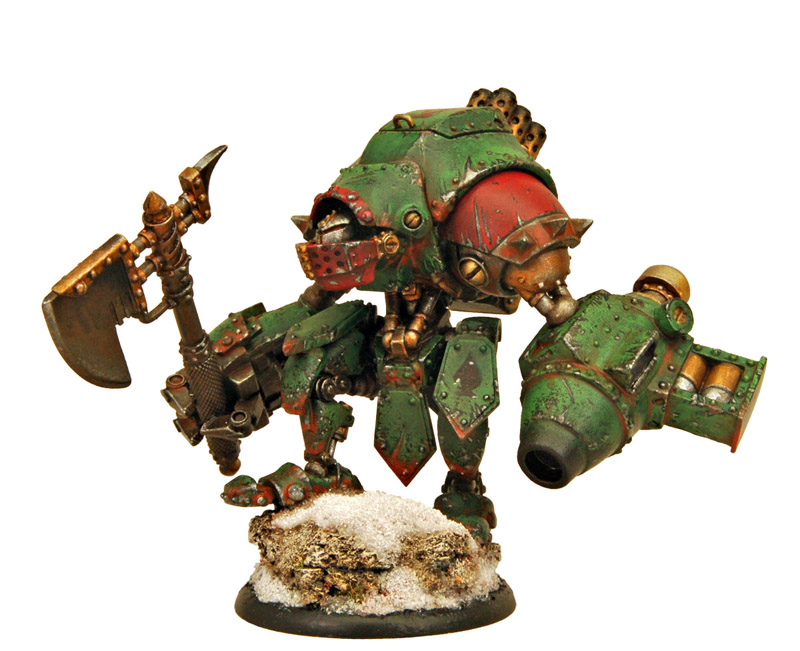Warmachine: Tactica- Lets talk Threat Density

In this article I want to discuss a tactical term that’s been around the WM community for a number of years: threat density. We’ll look at what it is, and the impact it has in the current edition of the game.
Threat density. The term has been around since Mk1, but I rarely see it discussed these days despite the large role it plays in list building. Threat density is a term applied to a unit in the game. It effectively means, how much damage potential the unit compared to the amount of space the model/unit takes up on the board. The Behemoth has a very high threat density. It’s got a lot of damage potential packed into a single large base. Vilmon would be a similar case. Lower damage output than Behemoth, but in an even smaller package.
By comparison, a unit of Knights Exemplar have a low threat density. As a group they can hit hard, but that power is spread out across multiple individual models. As a unit of single-wound infantry, it’s very difficult to position them so that all of the models can engage the same target and capitalize on that total potential damage output. You’re also faced with the fact that normally they cannot boost, and you’ll have more attack rolls to make, meaning it’s more likely you’ll see a couple models of the group missing their attacks or flubbing a damage roll.
In terms of maximizing damage output, it is simpler to have a few models with a high threat density, than multiple low-density units. Not only that, but since heavy Warbeasts and Warjacks tend to have higher melee potential than light’s (this isn’t necessarily the case with ranged weapons) while only being on a slightly larger base, we see more of an emphasis on fielding heavies than lights. Don’t believe me? Take a look at the tables at your LGS. Most of the light Warjacks and Warbeasts you’ll see will either be an arcnode, have a ranged weapon as their primary mode of attack, or have a melee weapon that’s more comparable to a heavy than other lights. You simply don’t see many light’s fielded with melee weapons in the P+S 11-14 range.
Right about now, some of you are shaking your heads wondering what the heck any of this means on the tabletop.
What this means is, barring any other factors, if you want to maximize your damage potential, you are best off sticking only to Warjacks and Warbeasts. There are several reasons that doesn’t happen. The first, is that Warjacks and Warbeasts require Focus and Fury to maximize their own capabilities. With Focus being a limited resource, there is a point of diminishing returns beyond which the Warcaster (and any “helpers” such as Thor, Strangeways, or a Vassal) simply can’t give out enough Focus on a consistent basis to maximize the potential of every Warjack on the field. In Hordes, Fury doesn’t have the same restriction. Beasts can make as much Fury as they can hold. The restricting factor there is having some means of removing enough Fury to eliminate or at least minimize any Frenzies. Fortunately, those helper models tend to be cheap- often just 1-2 points each. This is why it’s very common to see a Hordes army with just the Warlock, a few support models to mange the Fury, and have the rest of the list composed of Warbeasts.
Threat density does even more to drive list building. Because heavies are simpler to use, and therefore more ubiquitous in lists, units that can damage a heavy Warbeast or Warjack become more valuable, especially since the models that can damage a heavy can also take out single wound infantry. Stormfall Archers, Swordknights with flank, and weaponmaster infantry are just some examples. That’s not to say units like the Winterguard Rifle corps, Striders, or High Shields are bad, it’s just that fielding them means recognizing that if you come up against an opponent with little infantry, their usefulness will be limited, and so you rarely see those types of units fielded en-masse.
The one area where low threat density units shine is in board coverage and control. A heavy warjack, even one with reach, is unlikely to be able to engage more than 3-4 opposing models, unless his opponent has bunched up. This means that against, say Legion Swordsmen, a Phoenix heavy Warjack will be able to get in and kill perhaps 3 models of a potential 10 strong unit (without the UA). In the following turn, the Phoenix will need to weather 7 P+S 11 Weaponmaster charge attacks, which should seriously damage the jack, if not kill it outright. That one Warjack can affect only a 5.5″ bubble (if it has reach), or a couple enemy models, in melee each round. Compare that to a full 10-strong LD 8 infantry unit which can attack 10 separate targets each turn across 17″ of the board- more if the unit has multiple attacks, more if it has LD 9 or 10, and even more than that if it has Reach.
Infantry is much more flexible and allows a canny player to apply force to widely dispersed areas across the table. In scenario play, the lower density of an infantry unit also allows them to affect objectives far more easily. Consider this- in a capture-the-flag scenario, taking or contesting the flag with a Warjack means moving the entire 7-10 point model within 4″ of the flag. 7-10 points to contest or control an objective. An infantry unit can have just one model, so perhaps 1/2 to 1 point’s worth of power, and still contest an objective. 7 points versus just 1. The entire infantry unit will still need to get close in order to control the objective, but the low density permits a player to dedicate just a small fraction of the units’ power to deny an objective to his enemy. With a high LD, it’s even possible for one unit to contest multiple objectives. Not bad for a unit that’s likely worth 6-8 points.
That ends this lesson on threat density. For your homework, I’d like you to consider how you have applied this concept to your games and lists up till now. Your essays will be due next Friday. Class dismissed.





